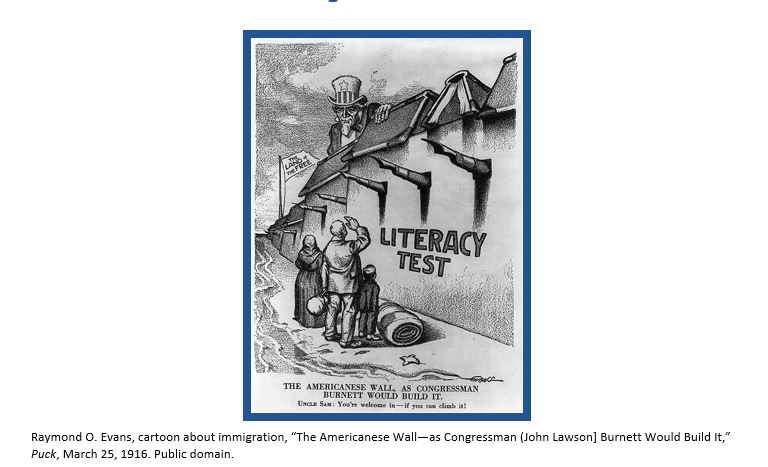11th Grade Immigration Inquiry
Is Anything New About Today's Immigration Policy Debate?
Download Entire Inquiry Here

Is Anything New About Today's Immigration Policy Debate?
Download Entire Inquiry Here
Staging the Compelling Question
This inquiry opens with the compelling question “Is anything new about today’s immigration policy debate?” To engage students in considering the question, teachers can ask them to examine political cartoons that address the current immigration debate. Teachers may use this experience to introduce some of the arguments that surround the issue and enable students to consider the possibility that today’s debate about immigration policy mirrors those that have occurred in the past.
This inquiry opens with the compelling question “Is anything new about today’s immigration policy debate?” To engage students in considering the question, teachers can ask them to examine political cartoons that address the current immigration debate. Teachers may use this experience to introduce some of the arguments that surround the issue and enable students to consider the possibility that today’s debate about immigration policy mirrors those that have occurred in the past.
Supporting Question 1-What is the current debate about immigration policy?
The first supporting question—“What is the current debate about immigration policy?”—establishes the context of the inquiry. Students should research a current national immigration policy issue. After doing so, students create a T-chart contrasting the arguments of policy supporters and opponents in order to have clear criteria to compare with the historical debates that make up the rest of the inquiry. The featured sources for this question are websites students can use to locate sources for their research.
- Suggested websites for student research
For teachers interested in a comprehensive resource, students can be directed to the immigration debate on the ProCon website, “What Are the Solutions to Illegal Immigration in America” (http://immigration.procon.org/), which should be updated as the current immigration debate evolves.
Another site is Opposing Viewpoints in Context. (Contact your librarian for information)
Teachers focusing on President Obama’s 2014 executive actions regarding immigration policy might direct students to the following sources:
- Fixing the System: President Obama Is Taking Action on Immigration, a 2014 video explaining the executive actions on immigration.
- “Executive Actions on Immigration,” description of the initiatives undertaken by the US Citizenship and Immigration Services, updated April 15, 2015 (http://www.uscis.gov/immigrationaction)
- Max Ehrenfreund, “Your Complete Guide to Obama’s Immigration Executive Actions,” Washington Post, November 20, 2014 .
Supporting Question 2- What factors have shaped US immigration policy arguments over time?
The second supporting question—“What factors have shaped US immigration policy over time?”—introduces historical immigration debates by encouraging students to consider why people believed particular approaches to immigration policy were necessary. The formative performance task for this supporting question calls on students to compare and contrast arguments made by government officials in defense of particular approaches to immigration policy. Teachers might choose to have students, before writing their paragraph, first create lists, a Venn diagram, or another organizer that highlights the specific pieces of the arguments made by government officials. By examining the beliefs and events that shaped the policies’ development, students are able recognize patterns across time as well as elements unique to each policy. Featured Source A is a speech by Representative Horace Davis about the exclusion of Chinese workers, Featured Source B is a New York Times editorial by Senator David Reed speaking to the issues around the Immigration Act of 1924, and Featured Source C is a speech by President Lyndon Johnson on the Immigration Act of 1965.
Supporting Question 3- How has the immigration system changed over time?
Featured Source A is an excerpt from "Chinese Exclusion Act (1882)." , Featured Source B is an excerpt from "The Immigration Act of 1924 ( the Johnson Reed Act)", Source C is an excerpt from the "Immigration Act of 1963 on Selected Population Characteristics of Immigrants to the United States."
Supporting Question 4- How has US immigration policy been criticized over time?
- Source A: Political cartoon, "The Americanese Wall as Congressman Burnett Would Build It." Available from the Library of Congress: http://www.loc.gov/pictures/resource/cph.3b00563/
- Source B: Senator Meyer Jacobstein of New York, congressional speech arguing against immigration restrictions, Congressional Record (excerpt), 1924
- Source C: Jennifer Ludden, transcript of All Things Considered program about immigration policy, “1965 Immigration Law Changed Face of America” National Public Radio, May 9, 2006 NOTE: Students should listen to the piece online at http://www.npr.org/templates/story/story.php?storyId=5391395.
| New York State Social Studies Framework Key Idea & Practices | 11.4 POST-CIVIL WAR ERA (1865–1900): Reconstruction resulted in political reunion and expanded constitutional rights. However, those rights were undermined, and issues of inequality continued for African Americans, women, Native Americans, Mexican Americans, and Chinese immigrants. Conceptual Understandings:
|
| Staging the Question | Examine political cartoons that address the current debate about immigration policy. |